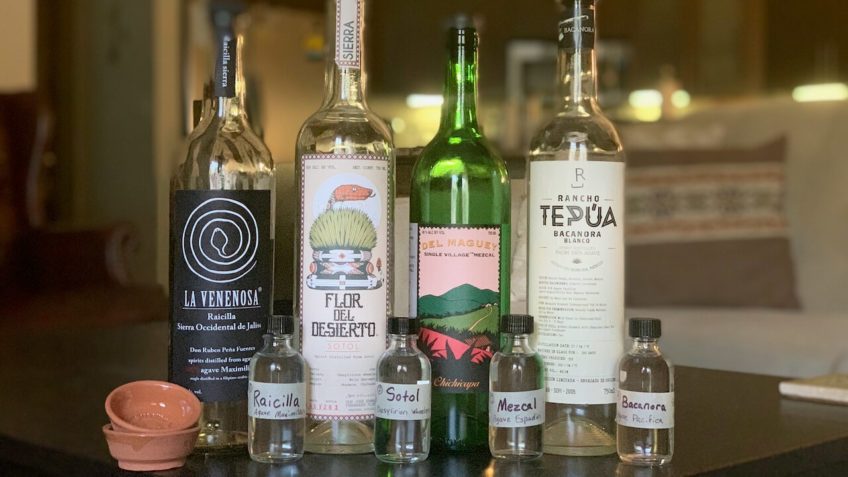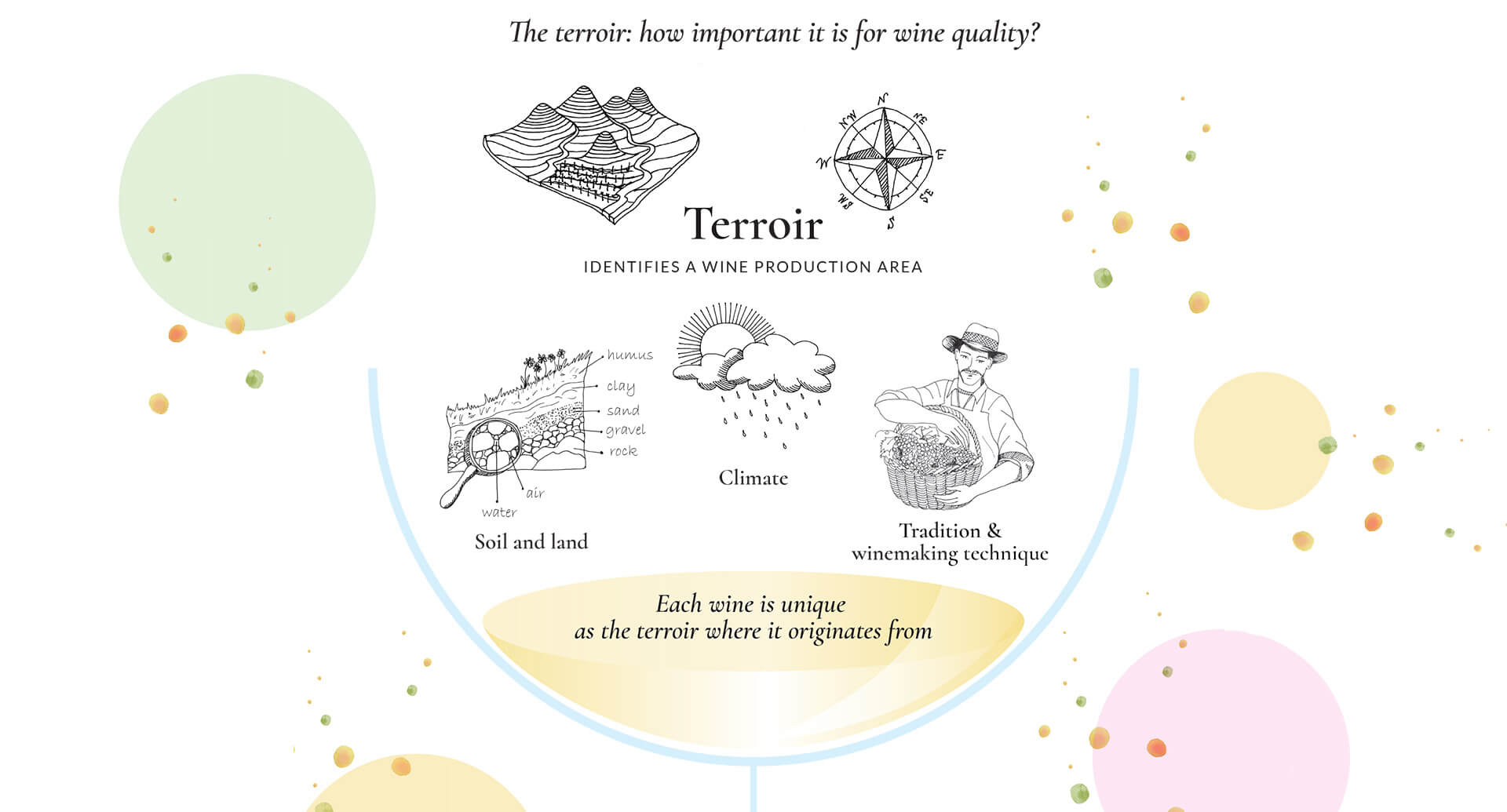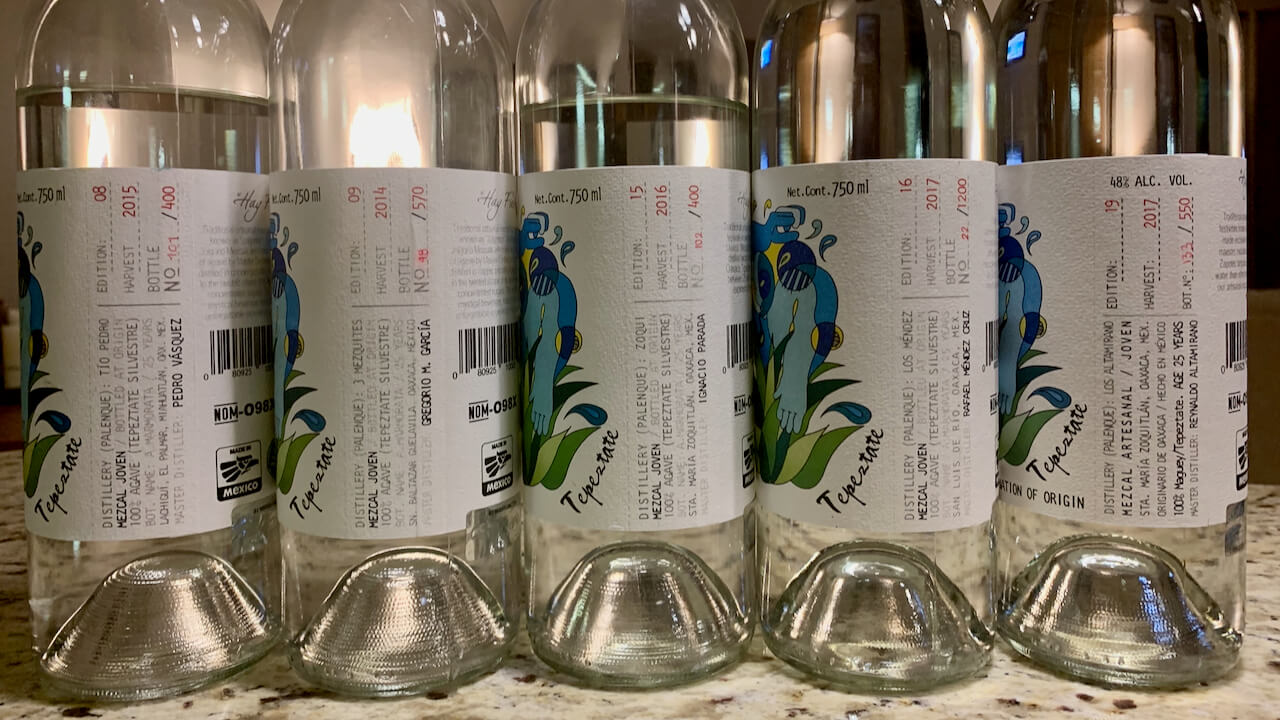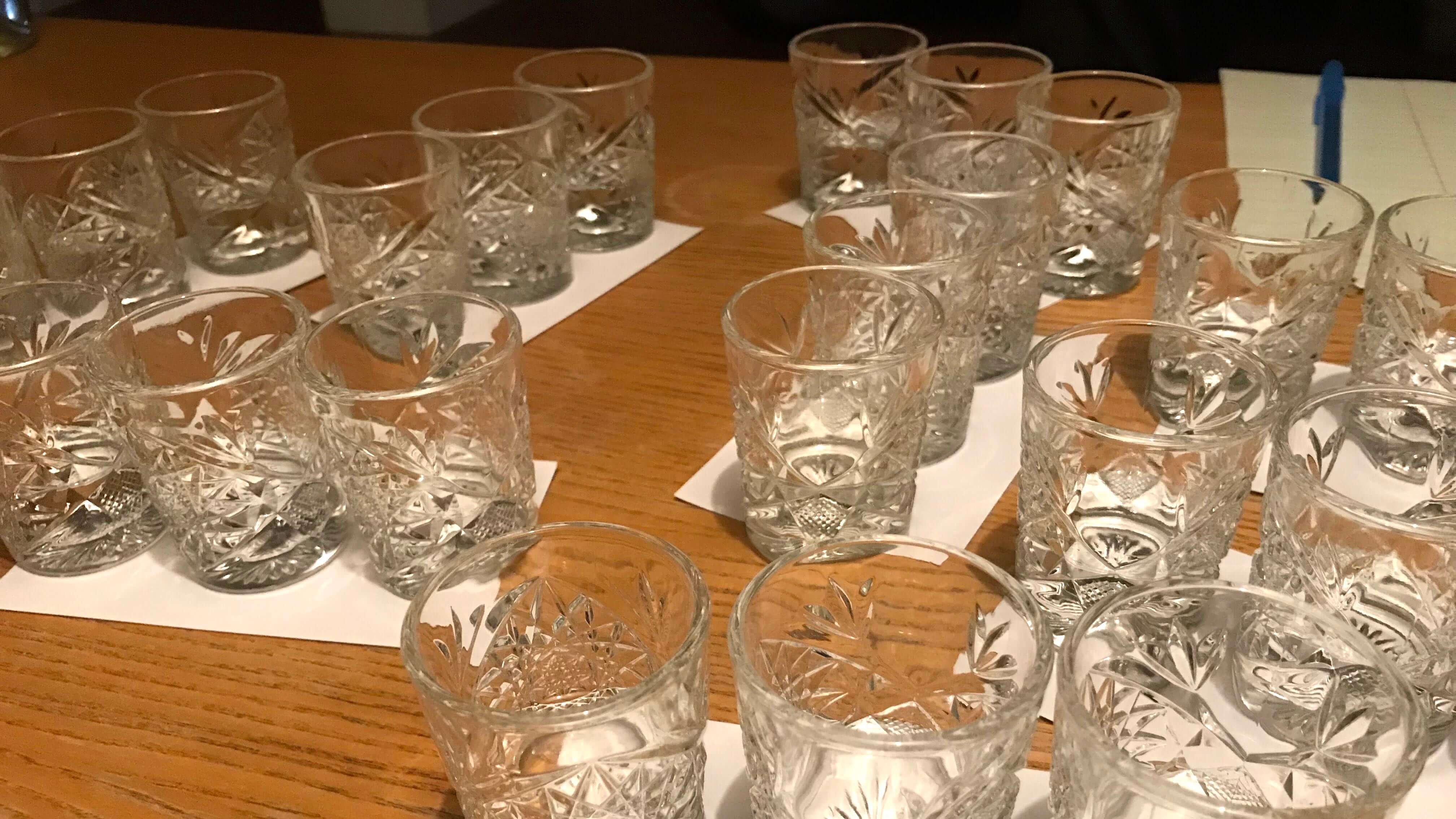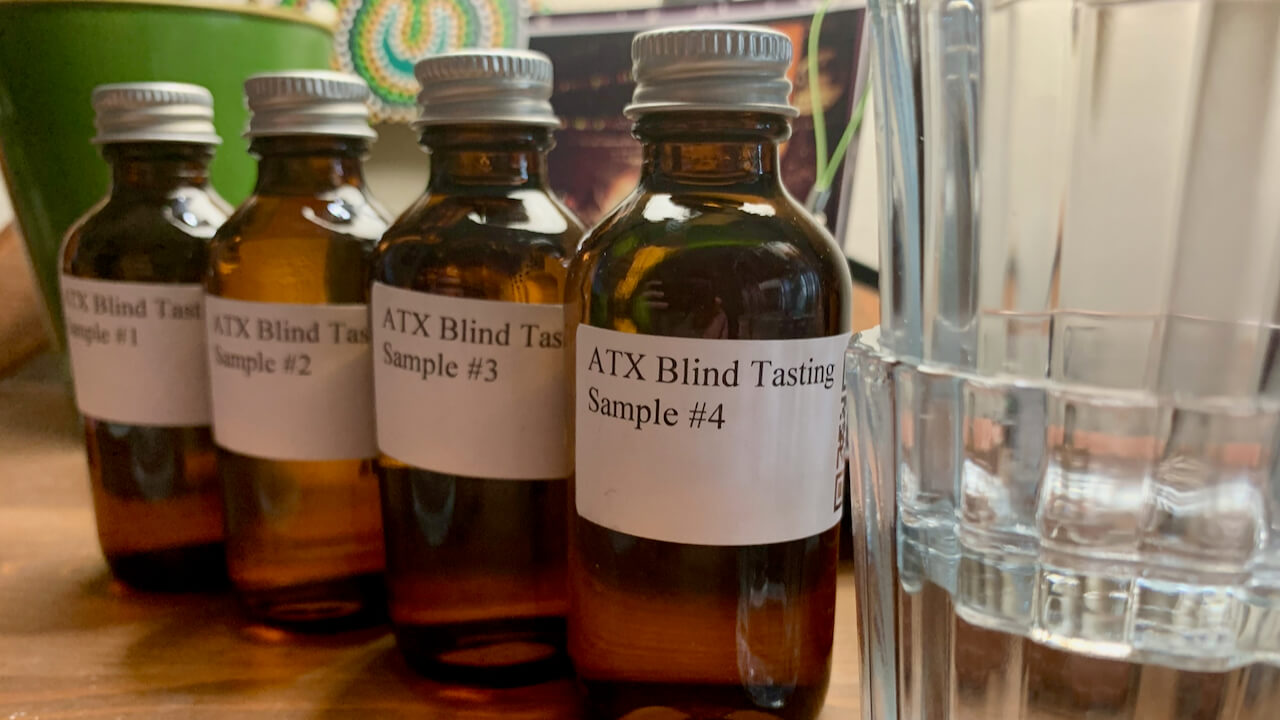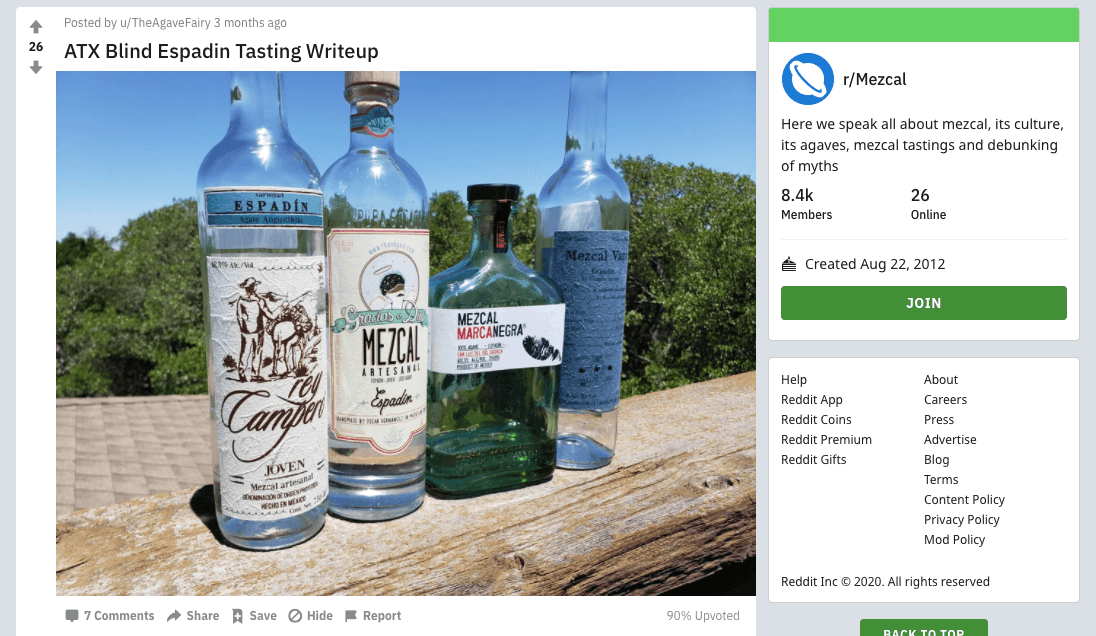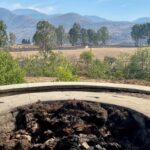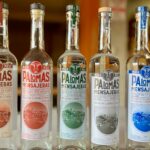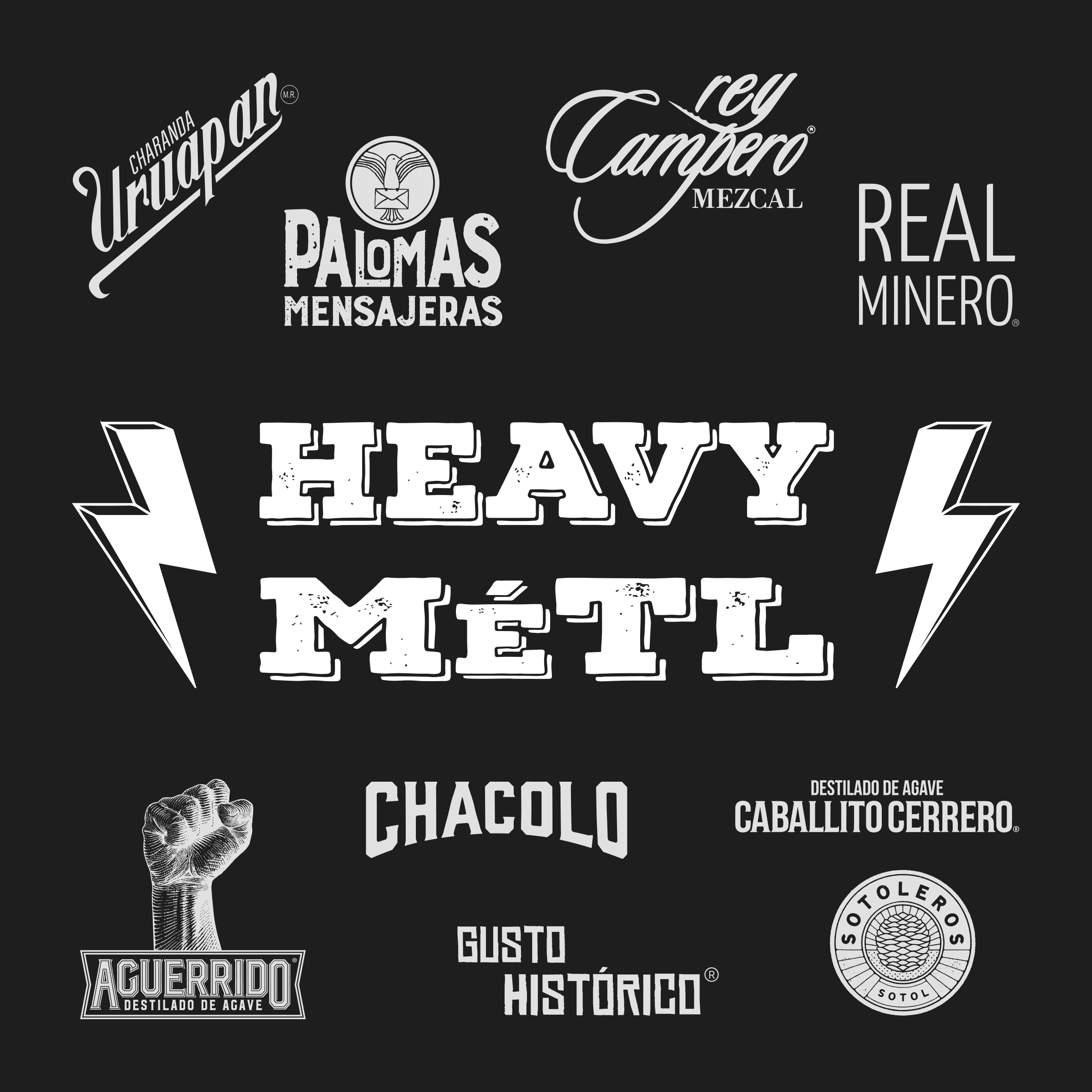No doubt you are spending more time at home right now if you live in the United States. The pandemic affects daily life and mezcal consumption is at an all-time high (as far as we can tell!). Our group of mezcal friends have been organizing mezcal tastings over Zoom and Hangouts these past few months. How do you arrange a virtual tasting? We will cover that later in the post. The original idea for this blog was to simply describe different styles of tastings. But given the current situation, we will share some of our thoughts on virtual tastings too. Either way, tasting random bottles can be fun but organizing a tasting around a theme is both educational and inspiring.
First off, let me give the California Wine Club credit for laying the groundwork for this post. They describe the following four types of tastings concisely in their blog 4 TYPES OF WINE TASTINGS TO TRY AT YOUR NEXT PARTY. Believe it or not, wine and mezcal have a lot in common. One could argue that mezcal has more in common with wine than distilled spirits. You may have heard the term terroir used when describing wine (and mezcal). Here is a description of terroir from Wine Folly:
Terroir is how a particular region’s climate, soils and aspect (terrain) affect the taste of wine. Some regions are said to have more ‘terroir’ than others.
This graphic from Terre dei Buth provides a nice visual.
Let’s break down a few of the points listed in the graphic as they relate to mezcal production:
- Soil and land. The district of Miahuatlan in Oaxaca is known for its mineral-forward water and rich soil. A friend once told us, “you can’t make a bad mezcal in Miahuatlán, their water is amazing!” They were referring to the local well water used in the fermentation step of mezcal production. Additionally, water might be used to adjust a “still proof” mezcal post-distillation.
- Climate. You might notice that bottles of Del Maguey usually reference the elevation of the production palenque. The climate at these various altitudes can greatly affect fermentation times. Certain producers only make mezcal during the warmer months because of this. Others might ferment for multiple weeks or use fermentation accelerants like pulque or natural bark.
- Tradition and technique. Towns like Santa Catarina Minas are known for clay-pot distilling. Ejutla has their refrescadera stills. We were told of a region where the locals preferred yellow tinted mezcal; the color was caused by rust in the lid of the still. Pechuga mezcals were traditionally produced for local celebrations, and even now that they are more commercialized they are only produced in certain regions of Mexico.
Of Spine or Vine?
It all starts in the dirt. Are there similarities between vineyards and agave fields? Agave Americana plants were given the name “Century Plants” because it was once believed they could live for 100 years. The most common variety of Agave used in mezcal, Maguey Espadin, typically reaches maturity after 6-8 years to. Other species like Maguey Tepeztate and Maguey Arroqueño can grow for 25 years or more before being harvested. In contrast, grapes are harvested seasonally every year. Grape vines, however, can grow for over 100 years if properly cared for!
A few years ago I was sitting at Espita Mezcaleria in Washington, DC. The resident agave-expert bartender, James, recommended I try a mezcal from Emanuel Ramos. “It’s straight mango”, he said. I don’t remember exactly what type of mezcal it was (also he may have said banana!), but sure enough it tasted like fruit. James had visited the palenque and said mango trees grew around the fermentation tanks at the Ramos palenque. This was a traditional mezcal, with no fruit added, and the fruit growing nearby influenced the flavor of the final product. For me, Mezcal Tosba is the same way. All of their expressions have a certain terroir that I believe is due to location of the palenque in a lush valley which we visited in 2019.
These basic examples point to the romantic definition of terroir – that the land is imparting flavors on the final product. It’s not all fluff however… science has proven that lands can impart unique microbes on the products produced within them. Now that we know what to look for, let’s learn about four different types of tastings.
Horizontal tasting
In the world of wine, a horizontal tasting might be one with wines from the same year, same region, or same type of grape. In mezcal, there are endless possibilities. The most accessible and interesting types of horizontal tastings are: mezcals from the same producer or mezcals from the same type of maguey. Early in our mezcal journey, we were surprised by the differences between Vago Espadin and Alipus San Luis (blue label); both are produced in the state of Oaxaca using 100% Maguey Espadin / Agave Angustfolia. It’s not a stretch to claim that a few humble tastings back in 2015 inspired the creation of this website.
A little Maguey Tobala tasting in September 2016 – the month the site launched!
Need some horizontal tasting ideas? Almost every year we organize tastings to celebrate our website anniversary with friends. Most of them are horizontal style tastings. Read the blog posts to learn more:
- 2017: Launch Party Mezcal Tasting
- 2018: 2nd Anniversary Party: Mezcal Tasting Results
- 2019: Mezcal Tasting: 3rd Anniversary Party
We had to cancel our anniversary celebration in 2020. Because of this, we promise double-down in 2021 with a TBOY tasting, the best one yet.
In September, we organized a tasting of five different editions of El Jolgorio Tepezatate… five! Each bottle was produced by a different mezcalero. You might be surprised by the range of flavor differences. You can discover the results in our blog post about it.
Vertical tasting
Vertical tastings might seem like the most nuanced type of tasting but they can be surprising. The idea is that you taste the same mezcal from different years or seasons. Since most mezcal is wild fermented, seasonal temperatures play a huge role in fermentation time. In turn, different fermentation times will create different flavors. There are many other factors that might change season to season which will affect flavors. For us, King Bee Lounge in Austin, Texas was a pioneer of vertical mezcal tastings.
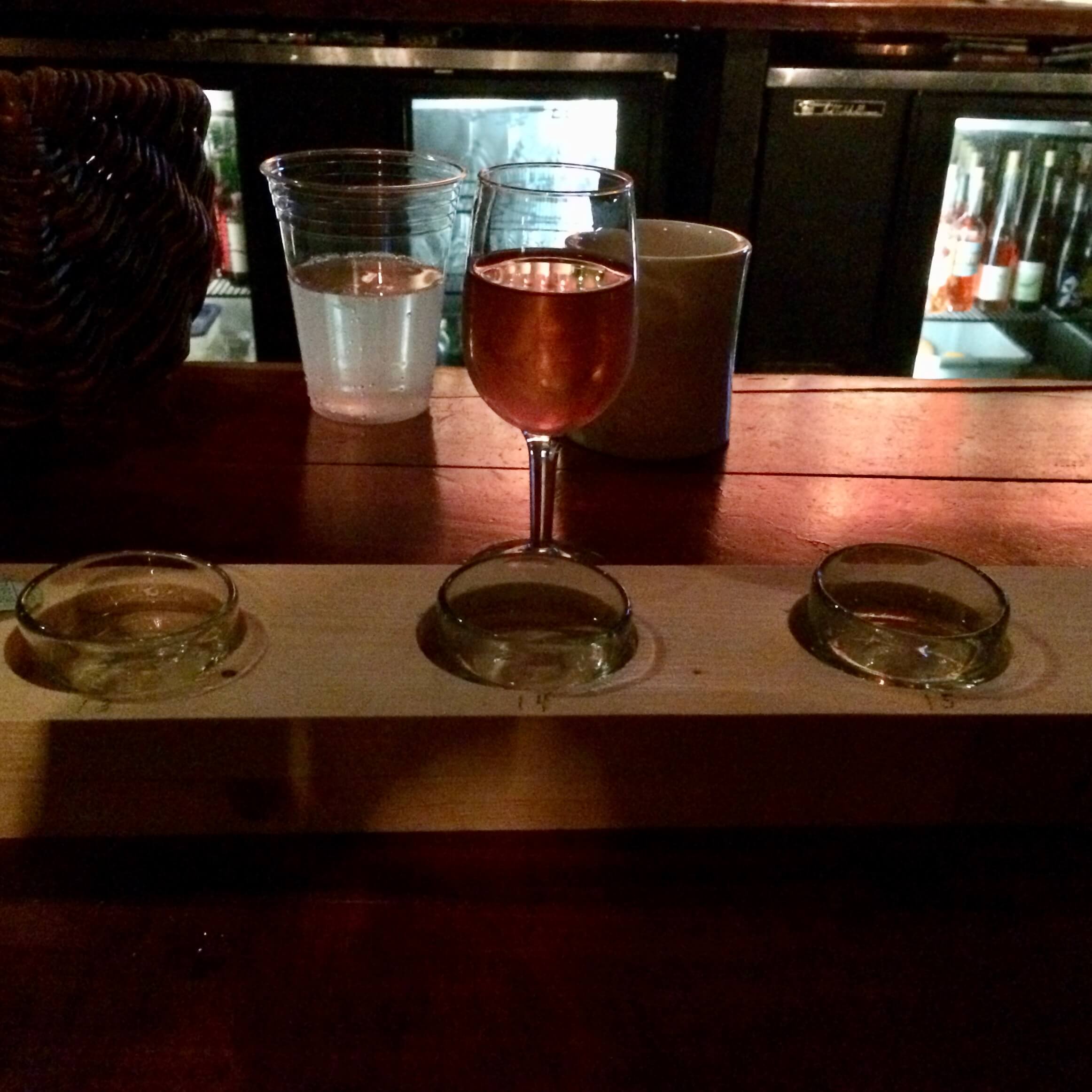
Mezcal Vago Cuixe from three different harvests paired with rosé wine (August 23, 2016)
Event description on Facebook:
Vertical flight of Mezcal Vago Cuixe (only 1 btl of each)
2013
2014
2015Paired with a glass of Laughing Pig Rose and a plate of roasted goat.
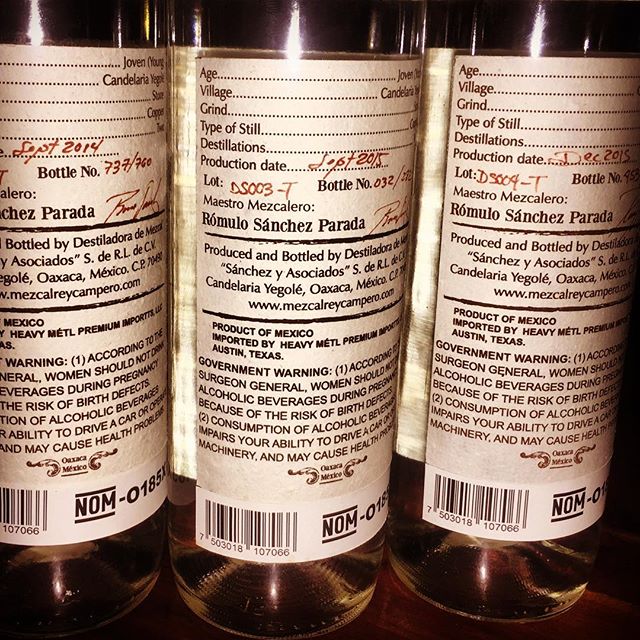
Three different batches of Rey Campero Tepextate (August 5, 2017)
Event description on Facebook:
Come down and meet Rómulo Sánchez Parada, his brother Vicente Sánchez Parada, and William Scanlan, the wondrous souls who make and bring us Rey Campero.
We will also be debuting a limited flight of the Rey Campero Tepeztate bottlings from Sept 2014, Dec 2015, and Sept 2015.
Both of the King Bee tastings were amazing. Each mezcal tasted vastly different. We had tried Rey Campero Tepextate before and thought it was pretty good, but one of the batches in the tasting was head and shoulders above the others. The day after the tasting, Jonny drove around Austin to find the specific mind-blowing batch of that Tepextate for his own collection.
It is worth noting that these separate tastings both featured mezcaleros from the remote village of Candelaria Yegole in Oaxaca. Their homes and palenques are down the street from each other. They both wild ferment and distill in copper but the mezcals they produce are very different. There is a regional terroir factor, but the technique of the maker cannot be overlooked.
As of this writing, we have only done one blog about a vertical tasting: Real Minero Pechuga Vertical Tasting
Blind tasting
Blind tastings are the perfect way to remove bias. It can be very easy to fall in love with a certain brand because of a special memory or the label artwork. Loss aversion as it relates to the sunk cost fallacy can play a factor too. It’s no fun to spend $100+ on a dud. In a blind tasting, you know which mezcals are “on the table” i.e. part of the tasting. But you won’t know which exact mezcal is in your glass until the tasting is over. Given the arrangement, you could try guessing what you are drinking during a blind tasting. However, even if one knows which bottles they are sipping they might not have tried them before. Blind tastings require a bit of setup, but are worth the effort. If you do it right, everyone involved can participate (unlike double-blind tastings). Check out the instructions in our first blind tasting blog from May 2017.
Dive into our previous blind tasting blogs:
- Blind Tasting: Agave Tepextate Mezcals
- Blind Tasting: Agave Tobala Mezcals
- Blind Tasting: Mezcal de Pechuga
- Blind Tasting: Agave Cuixe Mezcals
Double-blind tasting
Double-blind tastings are different than blind tastings. In a double-blind tasting, you don’t know which bottles are being poured. These have become especially popular during quarantine life. Some creative mezcal fans on social media platforms have been organizing virtual tastings. Some of the most interesting ones have been double-blind. For example, in one tasting the only information given was that the group would be sipping mezcal made from Maguey Espadin. After the bottles were revealed it was interesting to note additional similarities: all of the mezcals were distilled in copper in the state of Oaxaca. And even with all the similarities you could gather from reading a bottle label, each mezcal was very different.
Read more about the ATX [Double] Blind Espadin on Reddit. Another tasting from the same organizer was Agave Tequilana which featured both tequila and raicilla! Once you step outside the umbrella of mezcal, there are even more possibilities. The image at the top of this post is an example of going beyond mezcal. That was a Spirits of Mexico 101 tasting (minus Tequila) with Mezcal, Raicilla, Sotol, and Bacanora.
Flavor factors to consider when organizing a flight
When arranging any type of tasting, we recommend you pay attention to all of the production differences of each mezcal. Aside from the three terroir categories listed earlier, there are plenty of other things to consider when arranging a mezcal tasting. Okay, a lot of these might fit under the category of “technique” but bear with me.
Which production decisions influence flavor the most?
- Agave species and sub-species: Maguey Madrecuishe and Maguey Tobaziche are both Agave Karwinskii. Maguey Espadin is Agave Angustifolia.
- Mashing method: Hand mash with wooden tools, stone tahona mash, mechanically shredded, or a combination of techniques.
- Fermentation: Open-air natural fermentation in wooden vats (most common) or indoors with proprietary yeasts.
- Distillation types: Copper, clay, refrescadora, or other still types. Hand-made or professionally manufactured.
- Water: The other ingredient! Spring water, well water, or other sources used in fermentation. Sometimes added post-distillation to adjust the alcohol level.
Now we are familiar with the four types of mezcal tastings and the flavor factors to consider. Let’s 2020 this blog and talk about virtual tastings.
How to organize a virtual mezcal tasting
What if I told you that the Mezcal Reviews gang has plenty of experience organizing mezcal tastings? Shocking, right? Virtual tastings, however, are new to us. Your main tool will be the 1, 2, or 4 ounce glass bottles for trading mezcals. A small funnel will help too. Next, grab some paper tape and a sharpie to label to glass drams. If you and your friends live in the same city, it is simple. Meet at one location and trade drams. Finally, pick a time and choose your preferred video platform for the tasting.
If you don’t want to be in charge, seek one out on social media or elsewhere. You may live 3,000 miles from San Diego but you can join Tahona Bar for a virtual tasting. The same goes for organizations like The Crafty Cask. We live in Texas and have joined a few tastings via the Texas Mezcal & Tequila Society group on Facebook. The opportunities for tastings are greater than ever right now!
If you are reading this year(s) from now in a post-pandemic world where friends get together in close proximity to sip mezcal… well, lucky you.
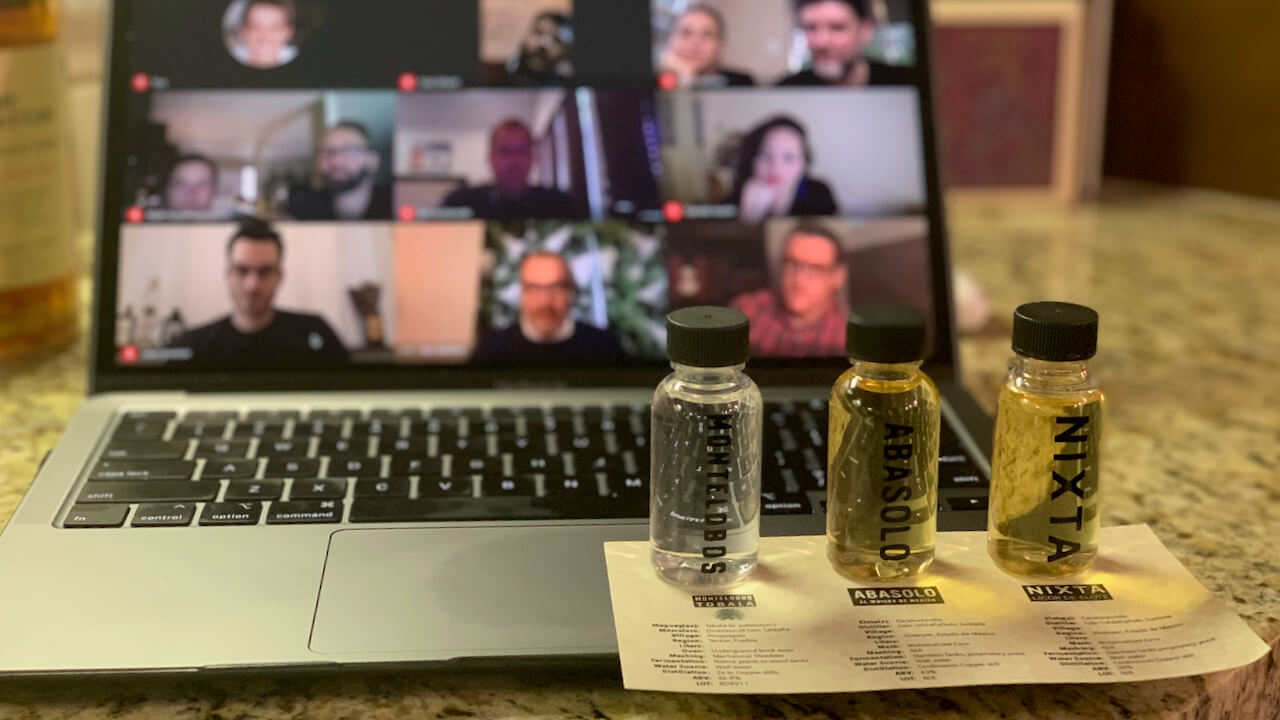
A virtual tasting of Casa Lumbre products with Iván Saldaña and the Texas Mezcal & Tequila Society Facebook group.
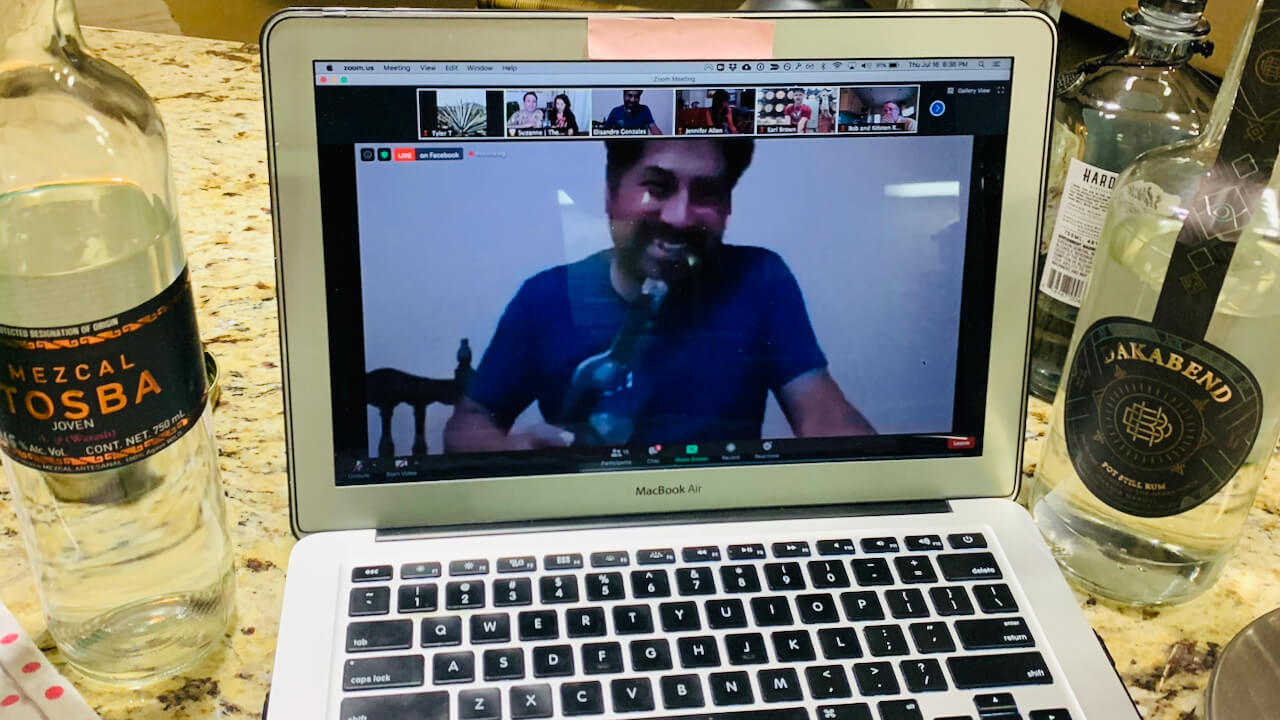
A virtual tasting of Dakabend Aguardiente de Caña with Elisandro González Molina and The Crafty Cask.
The best tasting?
As you continue down the road into agave spirits, a thoughtful tasting can open new doors. As a host, you can educate friends that are new to “smoky tequila”. Or join an online tasting and grow your circle of agave amigos. Maybe you both live in the same city and one day you can share your agave collections with one another? We hope this tasting blog and previous ones can be a resource for your journey of discovery. Also, use the term “terroir” with caution. People might get intimated and think mezcal is for wine snobs! There are plenty of other ways to flex your mezcal knowledge. Good luck and have fun. Share your tasting ideas and experiences in the comments below.


